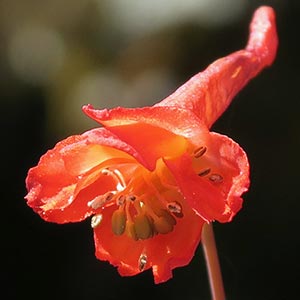Delphinium nudicaule
Delphinium depauperatum
canyon delphinium, canyon larkspur, orange larkspur, red larkspur, red or orange larkspur, scarlet larkspur
Blue Mountain, Blue Mountain larkspur, dwarf, dwarf larkspur, few flower larkspur, mountain larkspur, or mountain larkspur, slim larkspur
(15-)20-50(-125) cm;
base reddish, glabrous.
unbranched, 10-40(-70) cm;
base usually not reddish, nearly glabrous.
blade round to pentagonal, 2-6 × 3-10 cm; ultimate lobes 3-12, width 5-40 mm (basal), 2-20 mm (cauline).
blade ± round, 1-5 × 1.5-9 cm, nearly glabrous; ultimate lobes 3-10, width 2-12 mm (basal), 0.5-3 mm (cauline);
margins of basal leaf, measured less than 1 cm from blade base, demarcating considerably more than 90° of arc when leaf laid flat;
cauline leaf blades much shorter than internodes.
5-20(-69)-flowered;
pedicel (1.5-)2-6(-8) cm, glabrous to glandular-pubescent;
bracteoles 14-20(-30) mm from flowers, green to red, linear, 2-4(-9) mm, glabrous to puberulent.
3-15(-25)-flowered, open, ± secund;
pedicel 0.5-3(-7) cm, ± glandular-puberulent;
bracteoles 2-6(-12) mm from flowers, green to blue, linear or lanceolate, 4-5(-8) mm, ± glandular-puberulent.
sepals scarlet to reddish orange, rarely dull yellow, glabrous, lateral sepals forward-pointing to form pseudotube, (6-)8-13(-16) × 3-6 mm, spurs straight, slightly ascending, (12-)18-27(-34) mm;
lower petal blades elevated, exposing stamens, 2-3 mm, clefts 0.5-1 mm;
hairs sparse, evenly dispersed, yellow.
sepals dark blue to bluish purple, puberulent, lateral sepals spreading, 10-14 × 4-7 mm, spurs straight, horizontal or nearly so, 12-16 mm;
lower petal blades somewhat elevated, ± exposing stamens, 4-7 mm, clefts 2-4 mm;
hairs mostly near base of cleft, white or light yellow.
13-26 mm, 3.5-4.5 times longer than wide, glabrous.
9-16 mm, 3.5-4.5 times longer than wide, ± puberulent.
unwinged or sometimes slightly wing-margined;
seed coat cells with surfaces smooth.
seed coat cells with surfaces roughened.
= 16.
= 16.
Delphinium nudicaule
Delphinium depauperatum
Delphinium nudicaule hybridizes with most other taxa of Delphinium that it encounters. Apparent hybrids involving D. nudicaule, and seen by the author (either afield or as specimens), include D. andersonii, D. antoninum, D. decorum, D. luteum, D. nuttallianum, D. patens, and D. trolliifolium. In addition, garden-grown plants have been hybridized with D. cardinale, D. elatum, D. menziesii, D. parishii, D. penardii, D. tatsienense Franchet, D. triste Fischer ex de Candolle, and D. uliginosum; D. nudicaule does not naturally occur with these species. Delphinium nudicaule is one of the earliest larkspurs to flower in any given locality. Douglas's type collection of D. nudicaule represents plants (synonyms D. sarcophyllum Hooker & Arnott and D. peltatum Hooker, an invalid name) grown under very moist conditions, probably quite near the ocean. The type specimen of D. armeniacum A. Heller represents plants grown under unusually dry conditions.
The Mendocino Indians consider Delphinium nudicaule a narcotic (D. E. Moerman 1986).
(Discussion copyrighted by Flora of North America; reprinted with permission.)
Delphinium depauperatum and D. nuttallianum are often found in the same meadows, with D. depauperatum occupying wetter sites, often very near streams, while D. nuttallianum is found in drier, better-drained sites. In typical years, the substrate will be dry around D. nuttallianum plants, while the substrate is damp near D. depauperatum plants as they flower. In addition, within a meadow, D. depauperatum flowers later than D. nuttallianum, so there is normally little overlap in flowering phenology of the two taxa. Although hybridization between D. depauperatum and D. nuttallianum is uncommon, hybrids do occur; they have been named D. ×burkei Greene. Burke's specimens at Kew represent a good series of permutations of this cross and successive backcrosses.
Specimens labeled Delphinium depauperatum subsp. harneyense represent the phase with more abundant yellow-glandular trichomes in the inflorescence and slightly larger flowers. Considerable variation in these features may be found within populations. Presence of yellow-glandular hairs is generally greater in more northern populations. Type specimens of Delphinium diversifolium are intermediate in amount of glandular pubescence.
Often confused with Delphinium nuttallianum, D. depauperatum may be distinguished by its cylindric inflorescences, less dissected leaves, winged seeds, and erect fruits. These character states contrast with the pyramidal inflorescences, more dissected leaves, ringed seeds, and spreading fruits of D. nuttallianum.
Dwarfed phases of Delphinium polycladon may be confused with D. depauperatum; they can be distinguished on the basis of bluish purple flowers, sigmoid pedicel, and prominent buds in the former, and dark blue flowers, straight pedicels, and absence of prominent buds in the latter.
(Discussion copyrighted by Flora of North America; reprinted with permission.)


